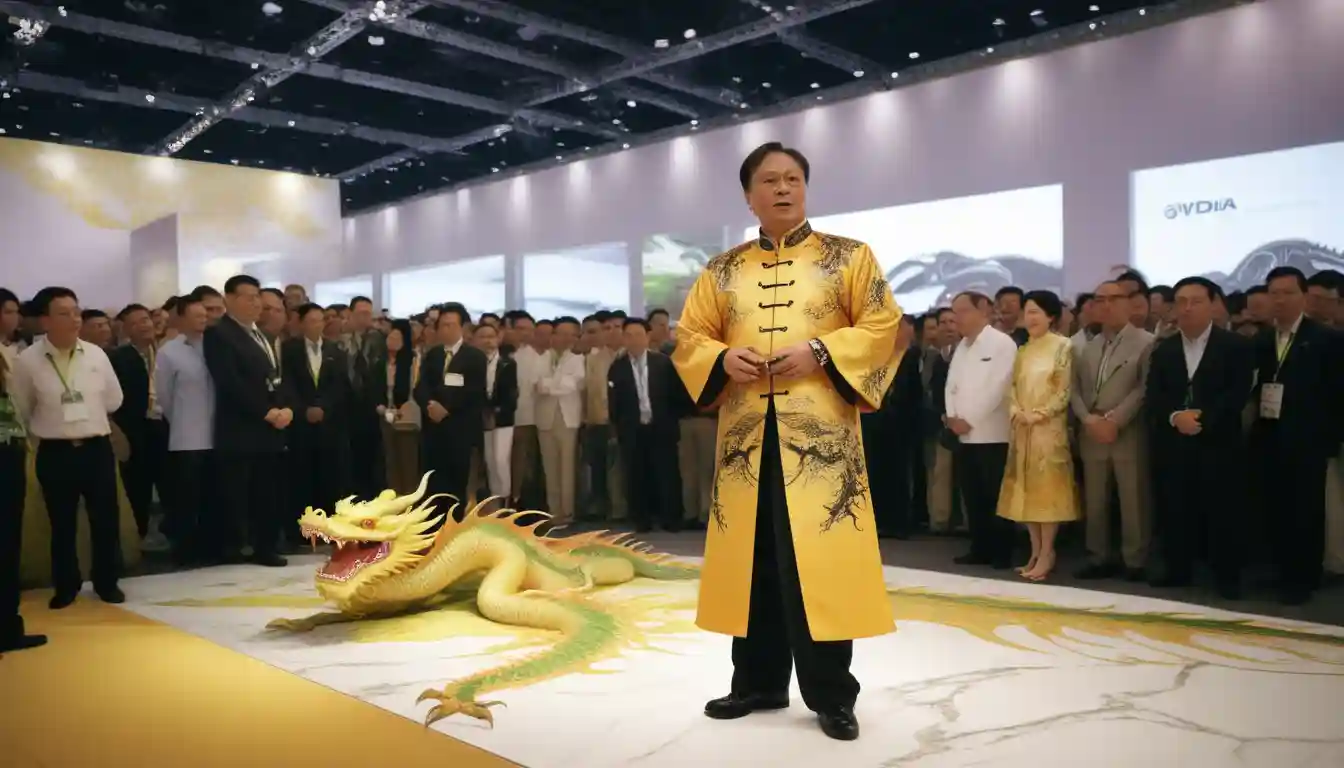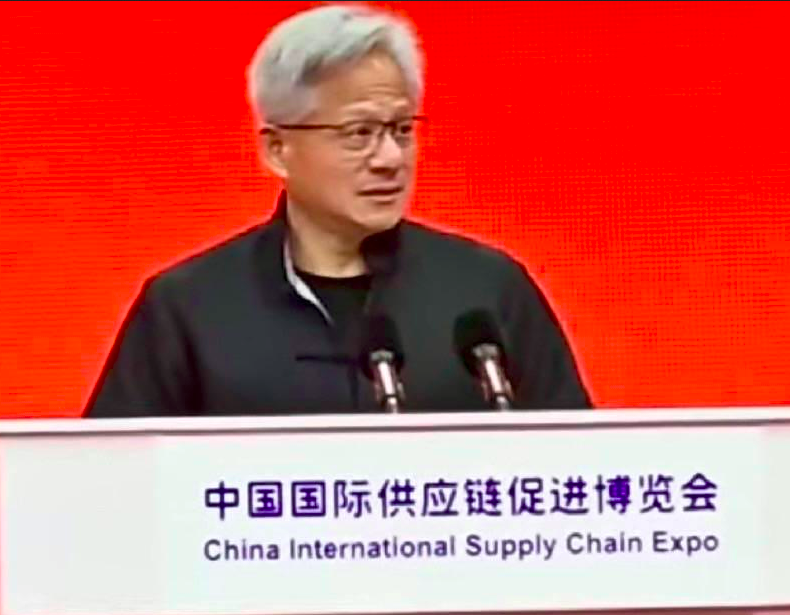
NVIDIA CEO Wears Tang Suit and Speaks Mandarin at Beijing Expo as Stock Rises 4%
In Symbolic Power Play, NVIDIA's Huang Courts China While Eyeing AI's Industrial Future
Draped in Tang Silk, Speaking Mandarin: The Theater of Tech Diplomacy
BEIJING — Dressed in a traditional Tang suit and addressing the crowd partly in Mandarin, NVIDIA CEO Jensen Huang performed a carefully choreographed dance of diplomacy and commerce at the 3rd China International Supply Chain Expo on Wednesday. His appearance, equal parts cultural homage and strategic maneuver, came at a pivotal moment in the fractured U.S.-China tech relationship.
"AI is the new infrastructure," Huang told the Beijing audience, positioning artificial intelligence as the fundamental underpinning of future economies, akin to electricity or the internet. His speech wove together praise for Chinese tech giants including Tencent, Alibaba, and ByteDance with announcements of new products designed to cement NVIDIA's role in China's industrial future.
The significance of Huang's appearance was not lost on market watchers. NVIDIA shares jumped 4% in pre-market trading to $170.70, as investors interpreted his overtures as a sign that the chip giant might preserve its crucial Chinese revenue stream despite ongoing export restrictions.

The Calculated Embrace: Symbolism Meets Silicon Strategy
Behind the cultural gestures and technological evangelism lies a sophisticated business strategy, according to industry analysts familiar with NVIDIA's operations in China.
"What we witnessed wasn't just cultural appreciation—it was a masterclass in business diplomacy," noted one technology analyst who requested anonymity due to sensitivity around U.S.-China relations. "Every compliment Huang directed at Chinese tech firms doubles as a reminder of their dependence on NVIDIA's ecosystem."
The timing proves particularly critical. NVIDIA recently secured U.S. approval to sell its H20 GPU to Chinese customers—a less powerful version of its flagship H100 chip that complies with export controls. With Chinese competitor Huawei gaining ground with its Ascend 910B chip, which reportedly outperforms the H20 by approximately 40% on certain workloads, NVIDIA faces unprecedented pressure in a market that generated $17.1 billion in revenue last year.
"The Next AI Wave Will Be Robotics": Seeding Tomorrow's Market
The most revealing aspect of Huang's speech wasn't about current products but his vision for AI's next frontier. "The next AI wave will be robotics," he declared, outlining a future where software and AI power human-machine teams in factory settings.
This declaration came alongside the announcement of NVIDIA's upcoming RTX PRO series, specifically designed for digital twin technology and intelligent logistics applications—a clear bid to position the company at the center of China's manufacturing evolution.
"He's not just selling today's chips—he's creating demand for tomorrow's," explained a Hong Kong-based investment analyst. "By evangelizing AI-powered smart factories while China leads the world in industrial robot adoption, Huang is essentially seeding the market for NVIDIA's next generation of products."
Walking the Geopolitical Tightrope Between Washington and Beijing
Huang's speech represents a delicate balancing act in an increasingly complex geopolitical environment. While wearing traditional Chinese attire and praising local companies, he simultaneously positioned NVIDIA's platform as the backbone for over 1.5 million Chinese developers—a subtle reminder of the company's entrenched position.
The context surrounding the speech reveals mutual economic pragmatism between the U.S. and China. As the U.S. eased restrictions on the H20 chip, China relaxed controls on rare earth exports—practical concessions amid otherwise tense relations.
"Jensen is operating as a bridge in what has essentially become a tech cold war," commented a Beijing-based technology consultant. "His challenge is convincing China he's a partner while assuring the U.S. he's not enabling its strategic rival's rise."
This balancing act grows more precarious as NVIDIA faces potential anti-monopoly fines in China that could reach up to $5 billion, according to regulatory experts following the case.
"You Still Need Us": The Three-Layered Message in Mandarin
Industry observers parse Huang's speech as operating on three distinct levels, each serving different timeframes in NVIDIA's strategy.
In the immediate term, his cultural gestures aim to soften Chinese sentiment toward NVIDIA following U.S. export restrictions. The Tang suit and Mandarin speech segments represent what one analyst described as "a soft gesture to sell hard goods" in a market NVIDIA cannot afford to lose.
Strategically, by highlighting Chinese firms' achievements in AI, Huang reframes potential competitors as partners within NVIDIA's ecosystem. This approach aims to convert rivals into customers by deepening their dependence on NVIDIA's CUDA programming platform—a dependency that creates significant switching costs.
Looking further ahead, Huang's emphasis on industrial AI and robotics establishes a new battleground where NVIDIA can maintain leadership even as the generative AI boom shows signs of plateauing.
Market Ripples: Investors Decode the Dragon Dance
Wall Street's reaction proved immediately positive, with NVIDIA stock rising in pre-market trading following Huang's appearance and recent U.S. regulatory approvals. The company's shares have been volatile in recent months amid concerns about its exposure to China and the sustainability of AI-related spending.
Industry analysts suggest several potential investment implications from Huang's strategic positioning, though they caution that geopolitical risks remain substantial.
"The H20 chip represents clearance stock with a license wrapper," noted one semiconductor industry analyst. "While this preserves NVIDIA's market share, price compression seems inevitable given Huawei's domestic benchmarks."
In the medium term, experts point to NVIDIA's software ecosystem as its true competitive moat. "Switching an AI model from CUDA to alternative platforms represents a six-to-twelve-month engineering challenge," explained a software architect familiar with both platforms. "That timeframe gives NVIDIA significant breathing room even as hardware competition intensifies."
Beyond the Tang Suit: Reading Between the Lines
The most revealing aspect of Huang's performance may be what went unsaid. By simultaneously embracing Chinese cultural symbols while announcing products designed for industrial applications, he effectively pivoted the conversation away from consumer-facing AI—where export controls are strictest—toward manufacturing applications where regulatory scrutiny might prove less intense.
"The costume signals harmony, the Mandarin signals cultural respect, but the subtext is clear: NVIDIA still controls the compiler," observed one technology policy expert.
For investors watching this diplomatic theater unfold, analysts suggest maintaining a balanced perspective. The charm offensive may support near-term sales but pressure margins as competition intensifies. Meanwhile, NVIDIA's software ecosystem likely maintains the company's relevance in China longer than hardware advantages alone would permit.
Investment perspectives shared in this article represent analysis based on current market data and established economic indicators. Past performance doesn't guarantee future results. Readers should consult financial advisors for personalized guidance.